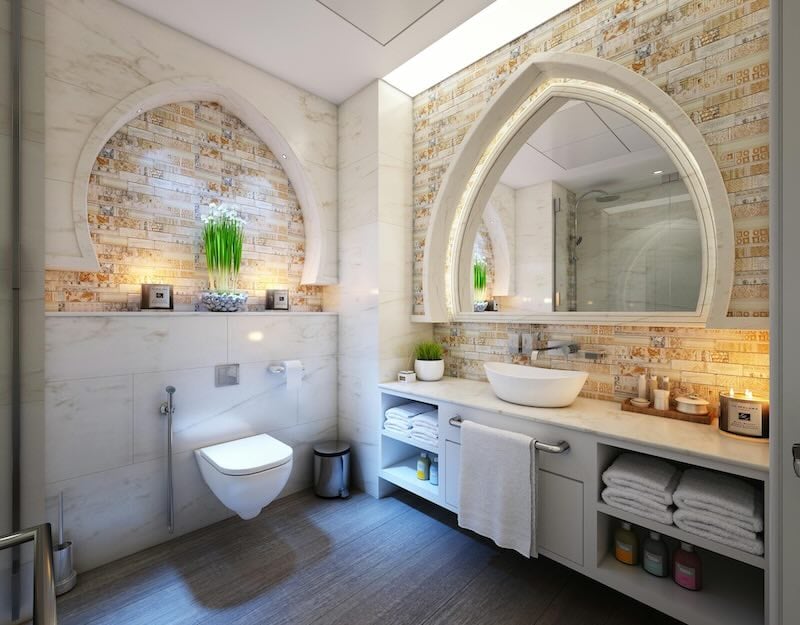Best Material for Bathroom Cabinets: What to Know Before You Buy
by Gary Wade • June 17, 2025
Choosing bathroom cabinet materials shouldn't be this complicated, but here we are. I think what makes it tricky is that bathrooms are basically moisture torture chambers for cabinets.
Steam hits them daily. Water splashes constantly. The humidity never really goes away, does it? Your cabinet material needs to handle all of this without falling apart or looking terrible after a few months. Kitchen cabinets have it easier, honestly.
Take solid wood, for example. Cherry, maple, oak. They're gorgeous materials. But stick them in a humid bathroom without proper sealing and they'll warp faster than you'd expect. Perhaps that's why we see so many beautiful wood vanities that look awful after a year or two.
Some materials surprise people, though. Marine-grade plywood actually outperforms solid wood in wet conditions. Stainless steel never fails, but not everyone wants that industrial look.
At Kitchen Cabinets Depot, we've installed enough bathroom cabinets to know which materials work and which don't. Thermofoil cabinets (MDF with a thermo-foil coating) perform better than most people think. Corian® creates these seamless designs that water can't penetrate. Even moisture-resistant MDF has its place if you seal it properly.
The thing about bathroom vanities is durability matters more than appearance, I suppose. You can find beautiful particleboard cabinets that cost half as much as other options. But moisture destroys particleboard quickly, so you end up replacing everything sooner than you planned.
Here are seven materials that actually work well in bathroom environments. Some cost more upfront. Others require specific installation techniques. But they'll handle whatever your bathroom throws at them.
Medium-Density Fiberboard (MDF)
MDF gets dismissed too quickly, which is a shame. It's actually a decent budget option for bathroom cabinets if you know what you're doing. The catch is understanding which type to use and how to protect it properly.
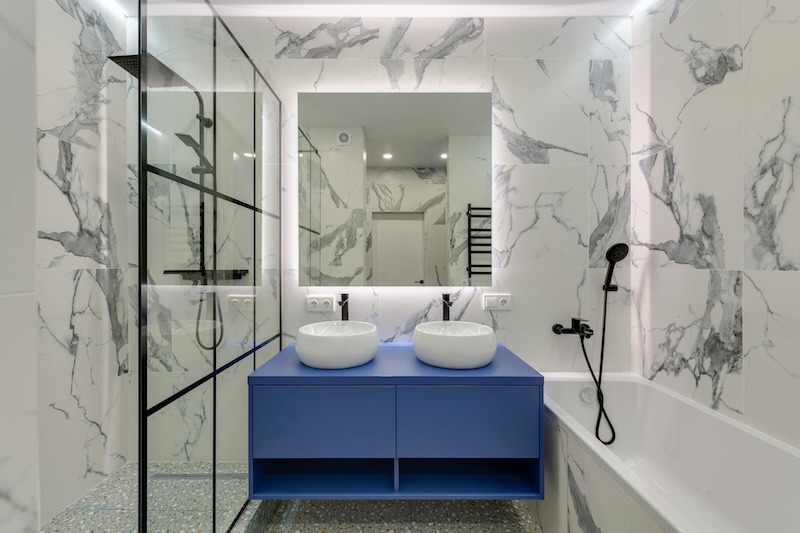
MDF overview
Think of MDF as sawdust and glue pressed together under intense heat and pressure. Wood fibers, resin, wax. All compressed into smooth panels without the knots and grain patterns you'd find in real wood. This makes it perfect for painted finishes, perhaps more so than solid wood.
The manufacturing process breaks down hardwood or softwood scraps into fine particles, mixes them with binding agents, then presses everything into consistent panels. MDF falls under engineered wood, not synthetic wood. There's a difference. Though people use the terms interchangeably. Density usually runs between 600 and 800 kg/m³, giving it a finer texture than particleboard.
MDF moisture resistance
Standard MDF and water don't mix well. Expose it to moisture without protection and it swells, then potentially falls apart. Not ideal for bathrooms, obviously.
But there's moisture-resistant MDF (MR-MDF) with added water-repellent agents. You can often spot it by the green core. It handles humidity better than standard MDF, though it's not waterproof. At Kitchen Cabinets Depot, we use MR-MDF for bathroom projects where occasional moisture is expected.
Even the moisture-resistant stuff needs proper sealing. Standing water or constant dampness will eventually cause problems. Sealing all edges becomes critical, regardless of which type you choose.
MDF durability and strength
MDF stays remarkably stable. It resists warping, twisting, shrinking, and seasonal expansion. This stability works well for intricate cabinet door designs or unusual shapes.
Expect 10-15 years from MDF cabinets, depending on your bathroom conditions and maintenance. The smooth surface takes paint and veneer applications nicely. Processing MDF into complex shapes is easier than working with solid wood.
The downside? Once damaged, you're usually replacing the whole panel. MDF doesn't repair well, unlike wood that you can sand and refinish.
MDF maintenance needs
Keep moisture away from MDF surfaces. For cleaning:
- Mix gentle dishwashing soap with warm water (one part soap to two parts water)
- Apply with a microfiber cloth, not directly on the cabinet
- Use circular motions for stubborn spots
- Dry thoroughly with a clean cloth immediately
Soft-bristled toothbrushes work for tough stains. Never let water pool anywhere or seep into edges, hinges, or damaged spots.
MDF pricing
Cost-wise, MDF wins. Bathroom cabinets typically run $70 to $250 per linear foot. Much less than solid wood options. Budget renovations often choose MDF for this reason.
With quality paint finishes, MDF cabinets can look surprisingly high-end despite the lower price.
Best use cases for MDF bathroom cabinets
MDF works well in:
- Modern bathrooms needing smooth, painted finishes
- Well-ventilated spaces with controlled moisture
- Vanity units away from direct water exposure
- Drier climates
- Budget renovations prioritizing appearance
For bathroom applications, use moisture-resistant MDF in:
- Vanity units and drawers
- Storage or linen cabinets
- Decorative paneling and trim
MDF isn't the most moisture-resistant material available. But properly sealed moisture-resistant MDF with quality finishes can work in ventilated bathrooms. The key factors are installation quality, edge sealing, and good ventilation to control humidity.
Solid Wood
"Solid wood shrinks and expands in width as the humidity changes, which could cause the paint line to crack over time where the panel meets the frame in a moist bathroom." - Danny Lipford, Home improvement expert and host of Today's Homeowner TV and Radio
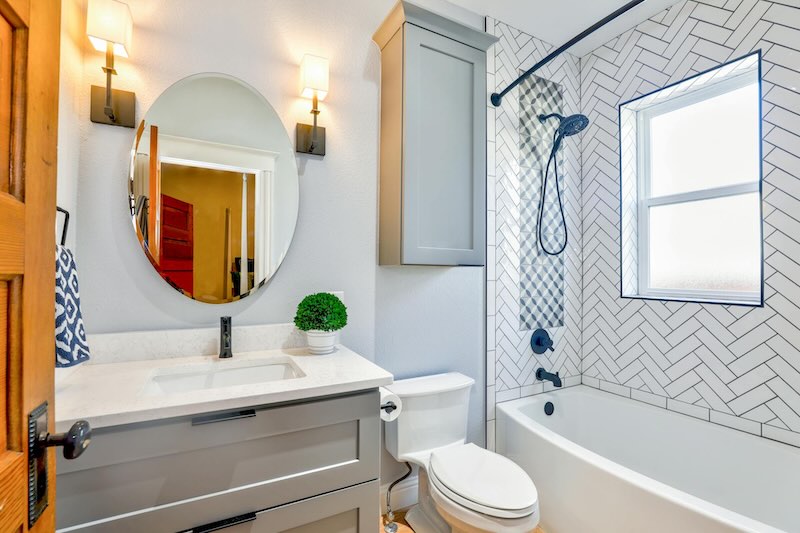
Solid wood bathroom vanities create something that engineered materials just can't match, though I'll be honest about the challenges we've seen at Kitchen Cabinets Depot. The warmth and character of natural wood can completely change how a bathroom feels.
Solid wood overview
You're working with complete pieces of timber here, not compressed materials or thin veneers over something else. Oak remains one of our go-to choices for bathroom vanities because of its exceptional durability. Maple, cherry, walnut, teak, cedar, Each brings different grain patterns and natural properties to the table.
There's actually a distinction worth noting between 100% natural wood and solid hardwood, though it depends on the specific timber used. Hardwoods like oak and maple typically outperform softer alternatives in bathroom settings. Maybe that seems obvious, but we've had customers surprised by the difference.
Solid wood moisture resistance
Here's where things get interesting, and perhaps a bit contradictory. Natural wood has this inherent relationship with moisture that's both a strength and weakness. Properly sealed solid wood can resist water damage quite well. But even with the best protective treatments, it still expands and contracts with temperature and moisture changes.
Different wood types handle humidity differently. Teak and cedar have natural oils that protect against moisture. Oak develops robust water resistance when sealed properly. Larch and robinia show excellent resistance thanks to their density and resin content. Yet we've seen beautifully sealed cherry cabinets warp in poorly ventilated bathrooms.
Solid wood durability and longevity
Properly maintained solid wood vanities can last 15 to 20 years, sometimes longer. What's nice about solid wood is how it actually improves with age, developing this natural patina that adds character.
The wood species matters significantly here. Oak and maple offer exceptional resistance to warping and humidity damage. Cherry looks gorgeous but needs more moisture protection to prevent warping. Walnut resists dents and scratches well, making it practical for busy family bathrooms. Though I've seen exceptions to all of these generalizations over the years.
Solid wood maintenance requirements
Maintaining solid wood cabinets requires attention, but it's not complicated. The key principle is simply "be gentle". Clean regularly. About every ten days with neutral detergent and a soft cloth.
Daily care includes:
- Wiping surfaces immediately after water contact
- Checking pipes for proper connections
- Placing heavier items on bottom shelves
- Opening and closing doors without slamming
Apply wood oil at least once yearly to nourish the timber. This treatment helps preserve wood integrity in humid environments, though some customers skip this step and still get decent results.
Solid wood pricing
Solid wood costs more upfront than engineered materials. Prices vary based on wood type and quality, but solid wood vanities typically fall into the mid-to-high range. Cherry sits in the mid-range category, with costs varying by thickness and grade.
Many homeowners view solid wood as a long-term investment despite higher initial costs. Whether that investment pays off depends on your specific bathroom conditions and maintenance habits.
Best use cases for solid wood bathroom vanities
We typically recommend solid wood for:
- Bathrooms with good ventilation and humidity control
- High-end renovations prioritizing aesthetics
- Spaces needing warm, natural elements
- Homeowners wanting long-term value
- Traditional or historically inspired designs
Solid wood excels where moisture levels stay controlled. An exhaust fan that runs during showers helps preserve wood integrity. Under the right conditions, solid wood offers an unmatched combination of beauty and durability. Under the wrong conditions, it can be frustrating and expensive.
Plywood
"While all three make excellent materials for painted cabinetry, on a bathroom vanity I would use a close-grained, hardwood plywood (like birch plywood) for the door panels, cabinet sides, shelves, and tall drawers; and a close-grained, solid hardwood (such as birch, maple, or poplar) for the door frames, small drawers, and cabinet face frame." - Danny Lipford, Home improvement expert and host of Today's Homeowner TV and Radio
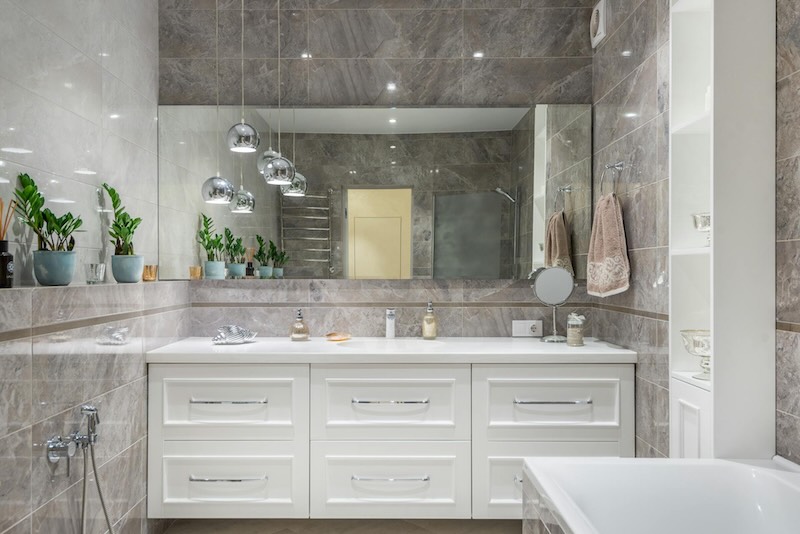
Plywood sits somewhere between solid wood and the cheaper engineered options. At Kitchen Cabinets Depot, we've noticed more people choosing plywood for bathroom cabinets lately, probably because it handles moisture better than solid wood without costing as much.
Plywood overview
Think of plywood as wood sheets stacked and glued together with the grain running different directions. Each layer pulls against the others, which keeps the whole thing from warping. It's engineered wood, but it still looks and feels like real wood because, well, it is real wood.
The manufacturing process bonds these thin sheets with strong adhesives. More layers usually mean stronger plywood, though that also affects the final thickness. What makes plywood different from solid wood is this crisscross construction that solves a lot of wood's natural problems while keeping the wood appearance people want.
Plywood water resistance
Standard plywood handles moisture better than solid wood, but it's not waterproof. You need specific grades for bathroom use:
- MR-grade plywood works for areas with light moisture
- BWR-grade handles kitchens and bathrooms with regular humidity
- Marine-grade plywood can take constant water exposure
Hardwood plywood like birch, oak, or walnut performs better in bathrooms than softwood versions. Some manufacturers add multiple polyurethane layers specifically for bathroom applications. The grade matters more than most people realize.
Plywood strength and stability
Here's where plywood really shines. Those alternating grain layers create structural strength that solid wood can't match. When moisture tries to make one layer expand, the layer above or below pulls it back into place.
Cabinet doors stay straight. Drawers don't stick. The whole structure remains stable even when humidity changes throughout the year. Weight gets distributed evenly across the board rather than creating stress points.
Plywood maintenance tips
Maintaining plywood cabinets is straightforward. Dust weekly with a dry cloth. Clean monthly with mild detergent or a vinegar-water mix. Wipe with the grain direction, not against it.
Water is still plywood's biggest enemy, even the moisture-resistant grades. Dry spills immediately to prevent warping. Harsh cleaners can damage protective finishes, so stick with gentle solutions. Soft cloths work better than scrubbing pads that might scratch the surface.
Plywood cost range
A 36-inch plywood vanity with ceramic sink typically runs $500-$800. That's considerably less than solid wood but more than particleboard options. The price reflects plywood's middle-ground position between budget and premium materials.
Best use cases for plywood bathroom cabinets
Plywood works well when:
- Moisture levels are moderate to high but not extreme
- You want wood appearance without solid wood maintenance
- Budget matters but you need something durable
- The cabinets will be painted or laminated for extra protection
- You're doing storage units or vanities that need structural stability
Marine-grade or BWR-grade plywood with proper edge sealing gives the best bathroom performance. You can paint it, laminate it, or add veneer depending on your design preferences. The versatility makes plywood appealing for different bathroom styles while maintaining practical moisture resistance.
Particleboard with Melamine Coating
Most people dismiss particleboard for bathrooms without really understanding melamine coating. At Kitchen Cabinets Depot, we've seen this combination work surprisingly well when installed correctly.
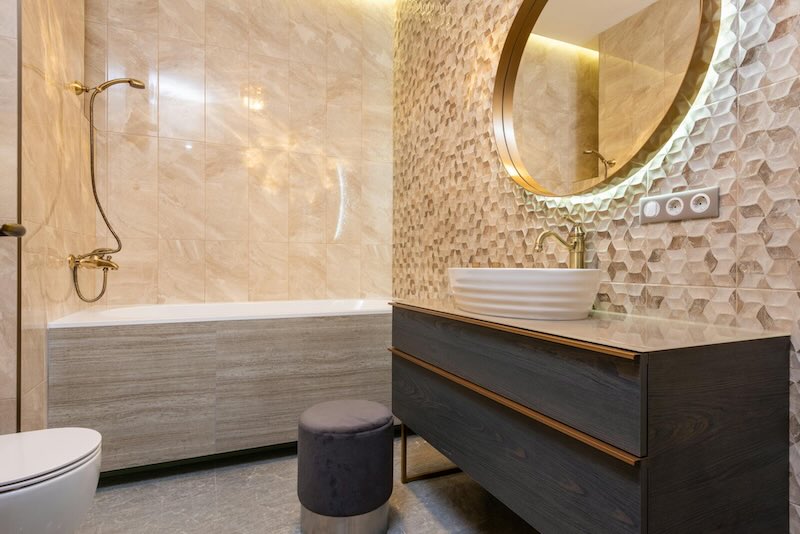
Particleboard overview
Particleboard starts with wood particles, sawmill shavings, and resin compressed together. The melamine coating changes everything, though. It's basically resin-impregnated decorative paper fused to the particle board under serious pressure—around 300-500 pounds per square inch.
The melamine isn't the core material itself. It's more like protective armor over the particleboard substrate. This thin plastic laminate layer creates a hard, non-porous surface that makes the underlying material much more suitable for bathroom use.
Particleboard water resistance
Here's where melamine coating really helps. The surface becomes substantially water-resistant, protecting the particleboard from brief water contact. The smooth coating repels water and oil, creating a barrier between moisture and the vulnerable core underneath.
But there's a catch. If moisture gets below the melamine surface through damaged edge banding or exposed areas, the particleboard core deteriorates quickly. Proper edge banding becomes critical in bathroom applications. Unsealed edges let moisture in, causing rapid swelling that happens at the molecular level.
Particle Board durability
For the price point, melamine-coated particleboard performs better than expected. The outer coating resists scratches, stains, and daily wear. This makes melamine cabinets workable for busy bathrooms where constant use might damage other materials.
Heat resistance is another advantage. Melamine handles heat better than some alternatives, so hair styling tools won't damage it as easily. The uniform construction also reduces warping and cracking over time.
Particleboard maintenance
Maintenance stays simple with melamine cabinets:
- Clean with mild soap and water using a soft cloth
- Dry spills immediately to prevent edge damage
- Skip harsh chemicals or abrasive cleaners
- Check edge banding regularly for peeling or damage
Moisture remains the main threat, so regular inspection of seals and edges helps catch problems before water penetrates.
Particleboard pricing
Cost-wise, melamine-coated particleboard ranks among the most budget-friendly bathroom cabinet options. It's generally cheaper than wood cabinets while offering similar looks. We see this appeal to homeowners renovating on tight budgets who still want a decent appearance.
Installation costs stay lower too since these cabinets assemble more easily, potentially reducing labor expenses.
Best use cases for particleboard bathroom cabinets
Based on our experience, melamine-coated particleboard works best in:
- Powder rooms with minimal moisture exposure
- Well-ventilated bathrooms with humidity control
- Storage cabinets away from direct water sources
- Budget renovations needing style without high costs
- Rental properties where cost-durability balance matters
Proper installation makes the difference. All edges need proper sealing, and cabinets shouldn't sit where standing water collects.
The variety of melamine finishes helps too. You can choose from different faux wood grains and solid colors, matching bathroom décor without real wood costs. This combination of affordability, decent durability, and design options explains why melamine-coated particleboard remains popular despite moisture limitations.
Stainless Steel
Stainless steel bathroom cabinets are kind of the gold standard for moisture resistance. At Kitchen Cabinets Depot, we see more homeowners choosing this material when they want something that absolutely won't fail them.

Stainless steel overview
These cabinets are made from corrosion-resistant metal alloy. Mostly iron, chromium, and sometimes nickel. Type 304 stainless steel has more chromium than Type 201, making it better for bathrooms. The material shapes well into different designs while staying strong even with heavy daily use.
What I like about stainless steel is its consistency. No surprises, no weird reactions to humidity.
Stainless steel water resistance
This is where stainless steel really shines. The chromium creates this thin protective layer that stops water, moisture, and chemicals from causing problems. You don't need special treatments or sealants. The protection is built right in. Testing shows 304 stainless steel can handle wet conditions for over 20 years without much maintenance.
Honestly, if you have a really humid bathroom or live near the ocean, this material just makes sense.
Stainless steel durability
These cabinets can last basically forever if you take care of them. They handle busy families, heavy items, constant opening and closing, all of it. The surface doesn't let bacteria grow either. Lab tests show stainless steel reduces common bacteria by up to 99% compared to other materials.
Bacteria resistance is something people don't always think about, but it matters in bathrooms.
Stainless steel maintenance
Keeping stainless steel cabinets clean is straightforward:
- Use mild dish soap and a soft cloth, wipe with the grain
- Stubborn stains come off with baking soda paste
- White vinegar removes water spots and fingerprints
Check them over and clean thoroughly every six months or so. Not much more to it than that.
Stainless steel pricing
These cabinets cost more upfront than other options. But the durability and longevity usually make up for the higher price over time. You're paying for something that won't need replacing.
Best use cases for stainless steel bathroom cabinets
We recommend stainless steel for:
- Master bathrooms with lots of humidity
- Coastal homes dealing with salt air and moisture
- Modern bathroom designs where the sleek look fits
- Family bathrooms that need easy cleaning and hygiene
- Commercial spaces requiring maximum durability
If moisture resistance and durability matter more than initial cost, stainless steel is probably your best choice for challenging bathroom environments.
Thermofoil
Thermofoil gets overlooked too often. At Kitchen Cabinets Depot, we've watched this material gain popularity, and it makes sense once you understand what you're getting.
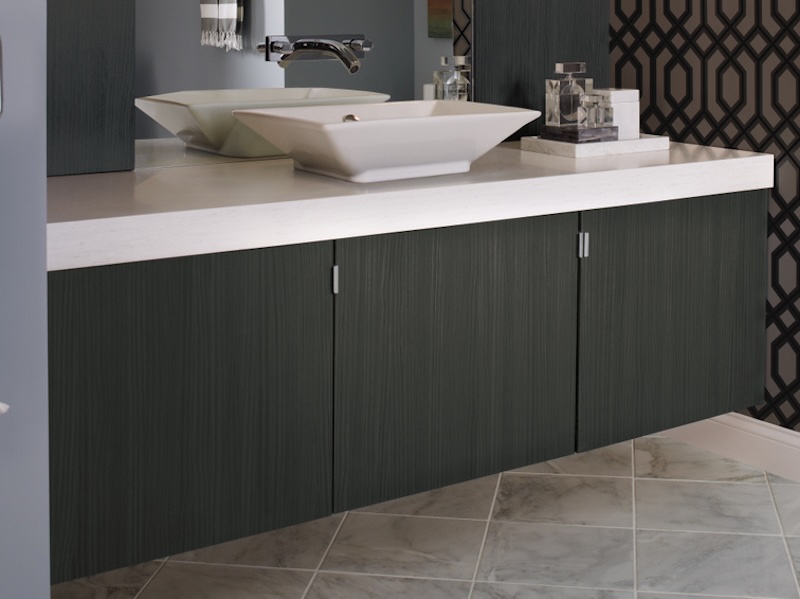
Thermofoil overview
Think of thermofoil as vinyl wrapping for cabinets. A thin vinyl laminate gets heated and pressed onto MDF under serious pressure. The result is a smooth surface that comes in various colors and finishes, including some convincing wood grain patterns. The vinyl completely wraps around the MDF core, creating a protective shell that changes how the underlying material behaves.
Thermofoil water resistance
Here's where thermofoil shines in bathrooms. The vinyl coating doesn't absorb water, which makes it naturally suited for humid spaces. Water beads up and wipes away easily. But there's a catch, and it's important. If that vinyl coating gets damaged or starts peeling, water can reach the MDF underneath and cause problems quickly.
Thermofoil durability
You can expect 10-15 years from thermofoil cabinets with reasonable care. They handle humidity better than solid wood, staying flat when other materials might warp. Daily use doesn't phase them much. They resist the kind of wear that damages other cabinet materials. Heat is their weakness, though. Hair dryers, curling irons, anything that gets hot can make the vinyl start peeling if it's too close.
Thermofoil maintenance
Maintenance stays simple with thermofoil:
- Weekly wipe-down with a soft cloth works fine
- Clean up spills right away, just in case
- Skip harsh cleaners that might damage the vinyl
- Keep heat sources away from the surface
Good bathroom ventilation helps prevent moisture buildup that could affect longevity.
Thermofoil pricing
Budget-wise, thermofoil makes sense for many projects. Stock options start under $100 per linear foot, while custom work runs around $350 per linear foot. Compare that to hardwood cabinets starting around $500 per linear foot, and you see why people choose thermofoil.
Best use cases for thermofoil bathroom cabinets
Thermofoil works well in:
- Modern bathroom designs where clean lines matter
- Bathrooms with decent ventilation and moderate humidity
- Projects where water resistance and budget both matter
- Spaces where you want low-maintenance surfaces
The variety of available finishes means thermofoil adapts to different design styles while handling moisture better than many alternatives.
Corian® and Solid Surface
Corian® gets mentioned a lot when people talk about premium bathroom materials. Perhaps that's because it actually delivers on most of its promises, though I think some homeowners expect too much from it.
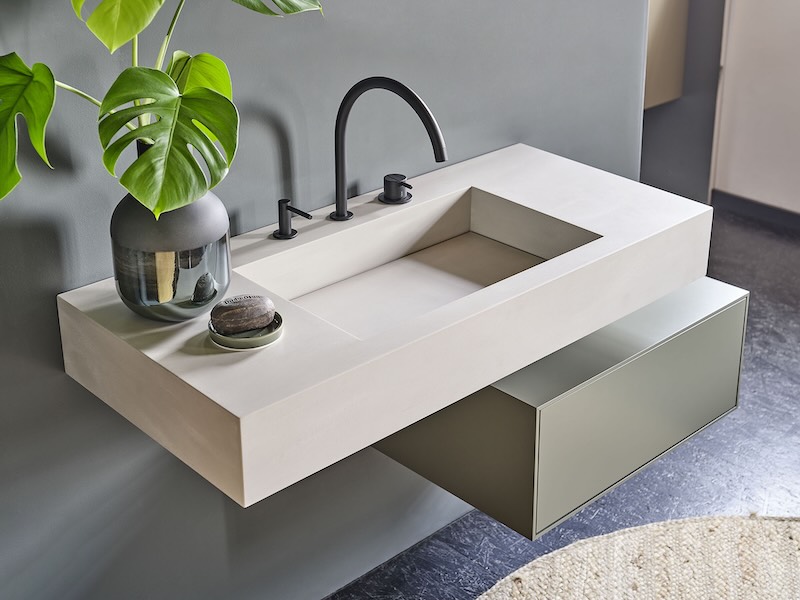
Corian® overview
Corian® is DuPont's solid surface material made from acrylic polymer and natural minerals. The thing about Corian® is you can mold it into almost any shape without visible seams. Unlike natural stone that needs joints everywhere, this stuff creates one continuous surface. It's engineered stone, basically, but it behaves more like a very hard plastic.
Corian® water resistance
Water can't penetrate Corian® because it's completely non-porous. No bacterial growth. No mold issues. No mildew problems. You never need to seal it, which is nice because sealing countertops every year gets old fast.
The water resistance is genuinely impressive, though it's not indestructible like some people think.
Corian® durability
Most Corian® vanities handle scratches and impacts better than you'd expect. Here's something interesting though. You can actually repair minor damage by sanding and polishing it back to new condition. Try doing that with granite or marble. You can't.
The material lasts well if you treat it reasonably. Not gently, just reasonably.
Corian® maintenance
Cleaning Corian® is straightforward:
- Mild soap and water with a soft cloth
- Skip harsh chemicals that might damage the surface
- Vinegar works for lime scale if you let it sit a few minutes
- Sand out scratches with fine-grit paper, then polish
DuPont backs it with a 10-year transferable warranty. That's confidence, I suppose.
Corian® pricing
Price-wise, Corian® sits in the middle range. More than laminate, less than high-end stone. The cost reflects what you get. Decent performance without the premium stone price tag.
Best use cases for Corian® bathroom vanities
Corian® works best when you want integrated sinks. The seamless look really shines in modern bathrooms where clean lines matter. Family bathrooms benefit from the hygiene factor too—easy to clean, hard for bacteria to hide.
It's not for everyone, but it handles bathroom conditions well enough.
Quick Comparison Guide
Here's how these materials stack up against each other. I've found this breakdown helpful when clients can't decide between options.
| Material | Water Resistance | Durability/Lifespan | Maintenance Requirements | Cost Range | Best Use Cases |
| Medium-Density Fiberboard (MDF) | Poor for standard MDF; Better with moisture-resistant MDF (MR-MDF) | 10-15 years | Regular cleaning with gentle soap; Immediate drying after contact with water | $70-250 per linear foot | Modern bathrooms with proper ventilation; Budget renovations |
| Solid Wood | Varies by wood type; Requires proper sealing | 15-20+ years | Regular cleaning every 10 days; Annual wood oil treatment | Mid to high range | Well-ventilated bathrooms; High-end renovations; Traditional designs |
| Plywood | Good with proper grade selection (MR/BWR/Marine) | High stability due to cross-grain structure | Weekly dusting; Monthly cleaning with mild detergent | $500-800 for 36-inch vanity | Moderate to high moisture environments; Budget-conscious quality renovations |
| Particleboard with Melamine | Good surface resistance but vulnerable at edges | Resistant to scratches and routine wear | Low maintenance; Regular edge inspection; Simple soap and water cleaning | Most budget-friendly option | Powder rooms; Well-ventilated bathrooms; Areas away from direct water |
| Stainless Steel | Excellent; Naturally moisture-resistant | Lifetime with proper care | Minimal effort; Clean with mild soap; 6-month inspections | High-end pricing | High-humidity environments; Coastal homes; Commercial settings |
| Thermofoil | Good surface resistance unless coating damaged | 10-15 years | Weekly wiping; Immediate spill cleanup; Avoid heat exposure | Under $100-350 per linear foot | Modern bathrooms with moderate humidity; Budget renovations |
| Corian® | Excellent; Non-porous | Long-lasting with 10-year warranty | Simple soap and water cleaning; Can be repaired if damaged | Mid-range | Modern designs; Family bathrooms; Integrated sink designs |
The pattern becomes pretty clear when you see everything laid out like this. Stainless steel and Corian® win on moisture resistance, but they cost more. MDF and particleboard save money upfront but need more careful placement and maintenance. Plywood sits nicely in the middle for most situations.
What strikes me is how much your specific bathroom conditions matter. A powder room with good ventilation can handle materials that would fail miserably in a steamy master bathroom.
What is the Best Material for Bathroom Cabinets?
Your bathroom cabinet choice comes down to matching the material with your specific situation. Moisture resistance matters most, but perhaps not in the way you'd expect.
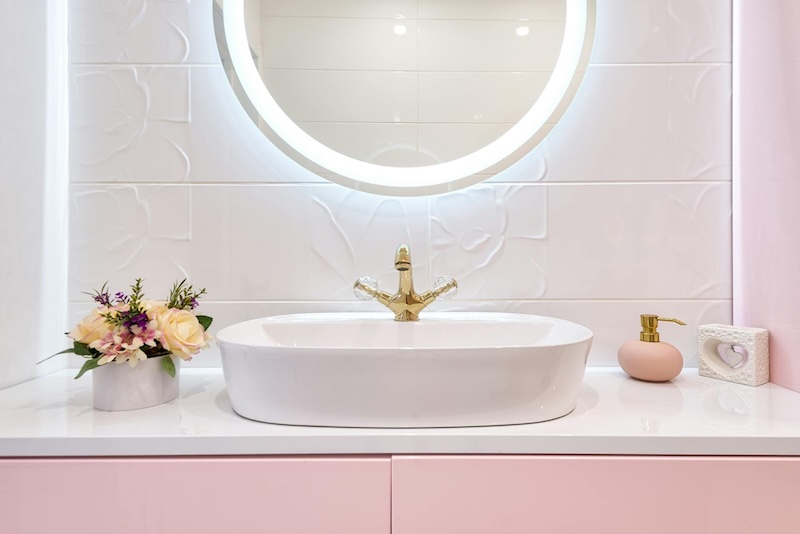
Stainless steel and Corian® handle water perfectly. Standard MDF needs protection, and solid wood requires proper sealing and maintenance. Plywood's layered construction gives it stability that surprises people. Thermofoil bridges the gap between looks and moisture protection reasonably well.
Budget plays a bigger role than most people admit. Particleboard with melamine works fine in powder rooms, but probably won't survive a busy master bathroom. Your ventilation setup actually determines which materials will work. Good ventilation opens up more options, including solid wood and better MDF grades.
We've installed enough bathroom cabinets at Kitchen Cabinets Depot to know this: match the material to your bathroom environment first, then worry about appearance. Consider your moisture levels, how much use the bathroom gets, and how much maintenance you want to do.
The perfect material balances water resistance, durability, upkeep requirements, and cost. All while fitting your design vision, which isn't always easy to achieve.
You have the information now to make a choice that works for your bathroom long-term. Ready to upgrade? Visit Kitchen Cabinets Depot for bathroom cabinets in all these materials, plus guidance to help you pick the right option for your needs and budget.
FAQs
1. What is the most durable material for bathroom cabinets in 2025?
Stainless steel is considered the most durable material for bathroom cabinets. It offers excellent water resistance, can last a lifetime with proper care, and withstands daily use in busy households. Solid hardwoods like oak and maple are also highly durable options if properly sealed and maintained.
2. What are the trending bathroom hardware finishes in 2025?
In 2025, sleek and modern hardware finishes are trending for bathrooms. Popular choices include brushed nickel, matte black, and polished chrome. These finishes add elegance and style to bathroom cabinets and fixtures, creating a polished and cohesive look.
3. Which material offers the best moisture resistance for bathroom cabinets?
Stainless steel and Corian® offer exceptional moisture resistance for bathroom cabinets. Stainless steel naturally resists corrosion, while Corian® is non-porous and prevents water penetration. Both materials are ideal for high-humidity bathroom environments.
4. What is a cost-effective yet durable option for bathroom cabinets?
Plywood with a water-resistant grade (like marine-grade or BWR-grade) offers a good balance of durability and affordability for bathroom cabinets. It provides better moisture resistance than solid wood and is more stable in humid environments, making it a cost-effective choice for many homeowners.
5. How do thermofoil cabinets perform in bathroom settings?
Thermofoil cabinets perform well in bathrooms with moderate humidity levels and proper ventilation. They offer good moisture resistance due to their vinyl coating, are relatively durable with a lifespan of 10-15 years, and are easy to maintain. Thermofoil is also budget-friendly, making it a popular choice for bathroom renovations.
overall rating: my rating: log in to rate



